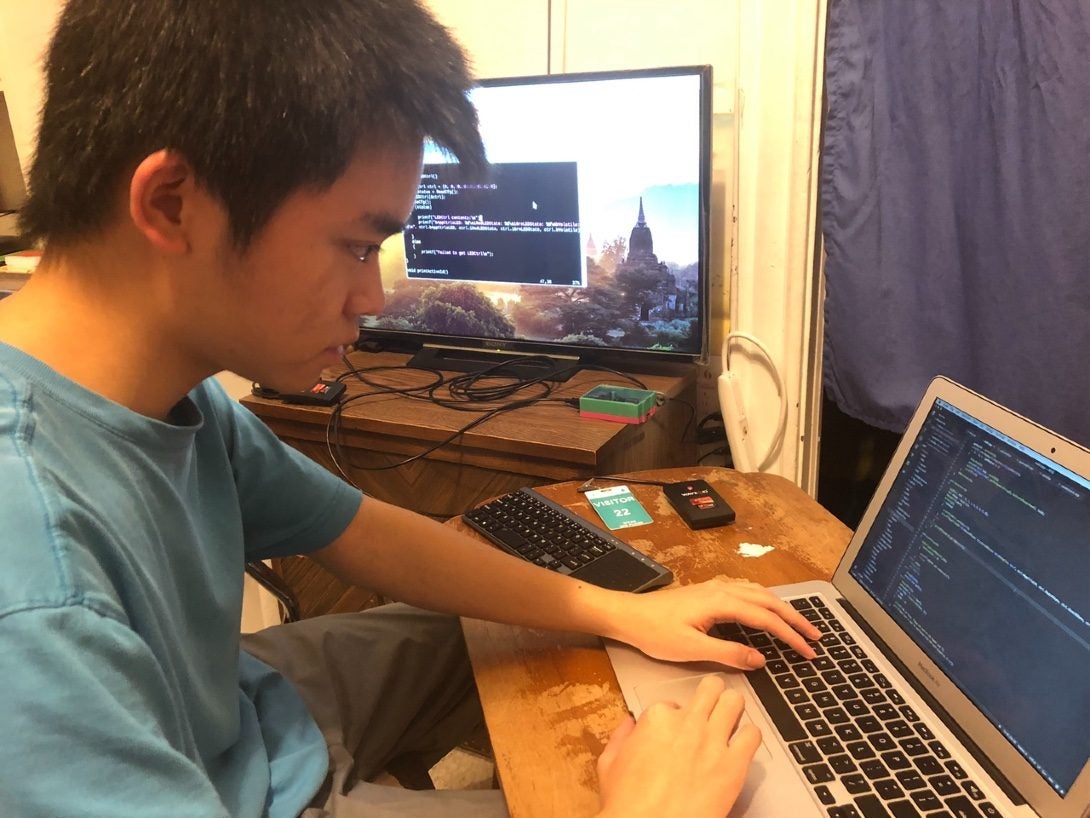ECE student Zhongyi Chen pivots from teaching Arduino workshops to developing tool to track COVID-19 exposure
ECE student Zhongyi Chen pivots from teaching Arduino workshops to developing tool to track COVID-19 exposure Heading link

When cases of coronavirus disease (COVID-19) began showing up at the University of Illinois Hospital & Health Sciences System (UI Health), administrators wanted an improved method of tracking the many hospital workers exposed to patients at high risk of contracting the disease, or who had been diagnosed with it. The system initially in use was a sign-in sheet posted at the doorway of a patient’s room that had to be scanned and manually entered into a database by hospital personnel, after the handwriting of each visiting worker had been deciphered. They turned to UIC’s Electrical and Computer Engineering Department for help.
The hospital has thousands of radio frequency identification readers (RFIDs), devices that use radio waves to transfer data from a tag to a reader. These will ultimately be implemented as part of a newer electronic health records system, but the thought was to press them into service to read employee’s ID badges during the pandemic.
“I’ve seen people track with a laptop and a barcode scanner. The problem is we don’t have enough laptops to man all the places we need to,” said Andy Boyd, MD, associate professor in Biomedical and Health Information Sciences. “And now, delivery dates are four to six weeks for computers, with everyone working from home.”
ECE associate professor Alan Feinerman brought in Zhongyi Chen, a student who was set to lead Arduino workshops for the department, to see if he could assist on the project. During the extended spring break, Chen got to work.
“I stated doing research on it — it was an interesting subject and I thought maybe in the future I’d learn it anyway, so I might as well learn it now,” Chen said.
He quickly realized that Raspberry Pi was a preferred option over an Arduino. While Arduinos are capable prototyping platforms for building electronics, the Raspberry Pi is more robust: it can plug into a monitor or TV, pair with a standard keyboard or mouse, and is a credit-card sized computer.
As Chen began working on pairing the Raspberry Pi’s with the RFID’s, he searched for tutorials online and discovered when people had used them, “it was when Windows XP was still a thing.” He quickly realized the sensors had to be programmed.
Jim Kosmach, a clinical associate professor in ECE with an extensive background working in industry, jumped on a call with Chen, and a software development kit was procured, which would provide the software and licensing needed to interface with the readers.
All the while, the needs of the hospital were changing: the system Chen ultimately designed includes 22 trackers consisting of one RF reader and one Raspberry Pi for each room, which can ping the hospital server every minute or so to let the system know it’s alive, a micro SD card to store data so it’s recoverable, lights that flash to provide a visual signal that entry into a room has been recorded, and a time and date stamp along with the employee’s name when they enter a room.
Given the high quality and speed of the work, one of the biggest surprises for Kosmach, Feinerman, and Boyd was the realization that Chen is only an undergraduate. He started college last fall, entering UIC as a sophomore.
“I thought Zhongyi was a grad student. He had been doing all this work, cranking it out, and Alan was like, ‘are you graduating soon?’ I think he was worried Zhongyi wouldn’t be able to continue on the project after the semester ended,” Kosmach said. “I was even telling my senior design students that their projects are very similar to this hospital project … you are doing A, B, and C and he’s doing A, B, and C—but in a very shortened time, all by himself, and he’s a sophomore.”
Boyd also praised Chen’s “magical work.” He said the hospital has yet to implement the RF system; a new and improved system with each staff member carrying personalized stickers with their data and photo has greatly improved the process, and the RF-Raspberry Pi system may be implemented when the initial hospital caseload declines.
Another option under consideration is to use the devices to track students, employees, and faculty as UIC’s campus is reopened.
Existing commercial employee tracking systems are cost-prohibitive, and installing tracking apps on phones or facial recognition software may be too big-brother for many people’s comfort level.
“As we bring people slowly back to campus, how do we know who’s been next to whom? What we’ve done is a solution that’s low-cost. It won’t be deployed tomorrow, but we develop potential solutions, and we are trying to make the best choices as things evolve,” Boyd said.
If the system were implemented across campus, the RF readers and Raspberry Pi’s could be used to read the i-Cards carried by all students, faculty and staff as they enter buildings, dining areas, or lecture halls.
Feinerman praised the Tinkering Program led by Sabrina Jones, which donated its 22 Raspberry Pi’s to the effort as materials were in short supply. He said he was pleased ECE could assist UI Health with this effort.
“When they asked for help, we wanted to make sure we answered,” Feinerman said.